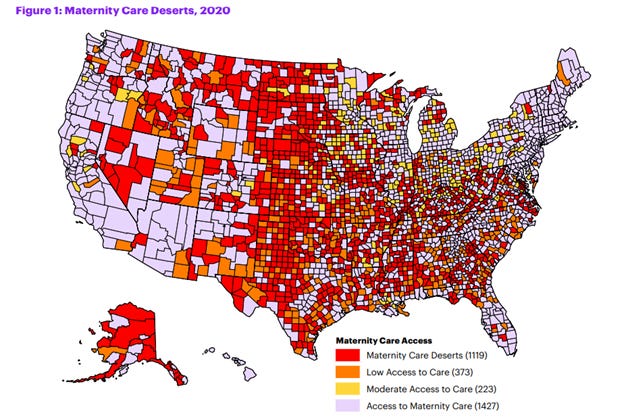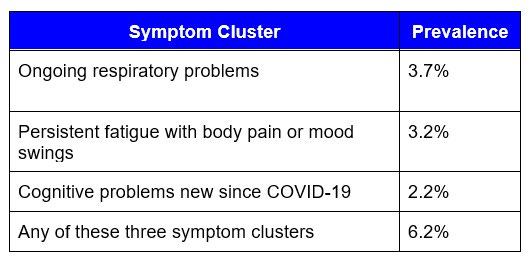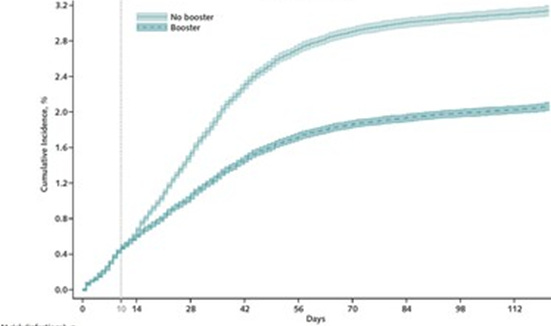Maternity Deserts, Colon Cancer Screening, Long COVID prevalence, and COVID-19 booster effectiveness.
October 14, 2022
Today, I’ll cover a March of Dimes report on maternity “deserts,” a large, randomized study on invitations to get a screening colonoscopy, a meta-analysis of frequency of Long COVID, and two new studies that demonstrate impressive effectiveness of vaccine boosters in preventing disease and hospitalization from Omicron. Pediatric COVID-19 boosters were approved, too.
1. Over 2 million women of childbearing age live in counties with no available maternity care
The March of Dimes reports that one in 20 American counties had less available maternity care in 2022 compared to 2020. About 2.2 million women (who had 150,000 babies last year) live in counties with no maternity care at all - no hospitals, no obstetricians, and no midwives. These “maternity deserts” are primarily rural, and women often have to travel over an hour to reach a provider. Telemedicine helped some get prenatal care remotely, but state regulations limiting telemedicine to in-state providers that were lifted early in the pandemic are now returning.
Source: March of Dimes, 10/10/22 LINK
Full access to maternity care is >=60 maternity providers per 10K births and more than one maternity facility
The lack of local maternity care contributes to the US maternal mortality rate, which is higher than any other developed country.
Employer implications:
- Employers can be sure that their plans fully cover nurse midwives and birth centers, and effectively communicate this to members. Midwives and birth centers have lower rates of medical interventions, and can expand access in communities which don’t have enough delivery volume to support other obstetrical providers.
- Employers can fully cover telemedicine for perinatal care, although state regulations sometimes limit availability
- Perinatal Quality Collaboratives, now active in 47 states, help maternity providers increase quality of care. Employers can advocate for their medical carriers to provide incentives to providers to join these collaboratives. The first of these collaboratives, in California, was associated with a 50% drop in maternal mortality in just 7 years.
- As rural hospitals increasingly shutter their maternity units, employers should be aware that some members will have substantial travel requirements, and need more time away from work to get necessary perinatal care.
2. New randomized study shows that colonoscopies significantly reduce colon cancers, but reduction of deaths does not reach statistical significance.
The New England Journal of Medicine reported on a randomized study of colonoscopy invitations given to almost 30,000 people ages 55 to 65 in Norway, Sweden and Poland. Those who were randomly assigned to this invitation were compared to about twice as many people who were not given this invitation. Of those who got the invitation, 42% actually got colonoscopies; the report does not say how many in the “usual care” group received a colonoscopy.
Those who got a colonoscopy invitation had statistically significantly fewer colon cancers than those who did not get the invitation. They had fewer colorectal cancer deaths, too, although this did not reach statistical significance. All-cause mortality was not different between the two groups. The colonoscopies were performed from 2009-2014, so a mortality benefit could still reach statistical significance with more time. Researchers reported that it took 455 invitations to prevent one case of colorectal cancer.
There has been a substantial decrease in colorectal cancer deaths in the United States associated with increase in colonoscopy. Colonoscopy screening is more common in the US than in these European countries:
Death rates from colorectal cancer by age group, US, 1999-2019
Source: Morbidity and Mortality Weekly Report, 2021 LINK
Implications for employers:
- This study shows that colorectal cancer screening did prevent colorectal cancer cases, and might well show decreased mortality with longer follow-up
- Other methods of screening, including FIT (fecal immunohistochemical testing) could be less expensive and easier to scale to the entire population
- Many deaths from colorectal cancer are preventable, and employers should continue to encourage evidence-based screening. National average commercial insurance screening rate is 62%
3.About 6% of those who recover from COVID-19 have clusters of symptoms three months later
The Global Burden of Disease workgroup from the University of Washington reviewed data from 54 studies from around the world and electronic medical records of 1.2 million people to assess how many who recovered from COVID-19 suffered from one or more of three symptom clusters suggestive of Long COVID three months later. This research was published in the Journal of the American Medical Association (JAMA) on October 10.
Their findings:
This study is important because of its massive size. The study included those who had infections until January, 2022, and therefore does not fully reflect the impact of Omicron. Omicron infections appear to result in fewer hospitalizations and fewer severe complications, and we don’t yet know if Omicron will be less likely to result in Long COVID.
Implications for employers:
- This estimate of persistent symptoms is lower than previous estimates of 20% or more, although this could still represent a staggering amount of future disability.
- Employers need to continue to be sensitive to the needs of those who have recovered from COVID-19 but have residual symptoms, and offer accommodations to the extent this is practical.
- We should expect to see an increase in short- and long-term disability, and Long COVID could continue to decrease the labor pool.
Two studies show effectiveness of mRNA boosters in preventing disease or hospitalization from Omicron
Researchers at the Veterans Administration compared medical records of almost 500,000 veterans who had COVID boosters with a similar number of medical records of people who did not have boosters. They found that those who had boosters were 42% less likely to get a COVID-19 infection, 53% less likely to be hospitalized, and 79% less likely to die of COVID compared to Veterans who had only the initial vaccination series. This data shows the importance of promoting boosters - although bivalent booster uptake in the US remains low.
COVID-19 Infection based on booster status
Source: Ionnaou, et al Annals of Internal Medicine October 11, 2022 LINK
A second study, published in BMJ, shows that among close to 4000 people hospitalized for respiratory illness with no immune compromise, initial vaccination series was associated with a 37% decrease in hospitalization, whereas one to two boosters was associated with a 63 to 65% decrease in hospitalization.
These large studies clearly show the benefit of getting a booster shot for COVID-19 protection. The new covalent vaccine should also provide good protection against a new variant, BQ.1, which is spreading rapidly in the United Kingdom. This new variant is resistant to monoclonal antibodies, but it is related to BA.5, the target of the new booster shots.
There has been some publicity about a small, poorly designed small study of death certificates in Florida that showed lower overall mortality in those who got vaccinated, but higher mortality in young men. Limited data about this study was released, and it has not been subject to peer review. Death certificates are notoriously unreliable, and the overwhelming evidence continues to show that vaccinations are associated with fewer infections, fewer hospitalizations, and fewer deaths. See links here, here and here.
Implications for employers:
- Employers should continue to encourage COVID-19 vaccination to decrease risk of infection, Long COVID, hospitalization and death.
- It’s a great time for employees to get influenza vaccine and the COVID-19 bivalent booster!
5. CDC approves bivalent booster for children ages 5 and up
The CDC approved the bivalent COVID-19 boosters for children ages 5 and up (Pfizer) and 6 and up (Moderna). These vaccinations should be available in the next few days. Pediatricians have been reporting an increase in respiratory infections in children as the weather gets cooler and children are back in school. This booster can help provide protection for kids and their families. All children over six months are recommended to get influenza vaccine, too.
Have a great (and safe) weekend!







